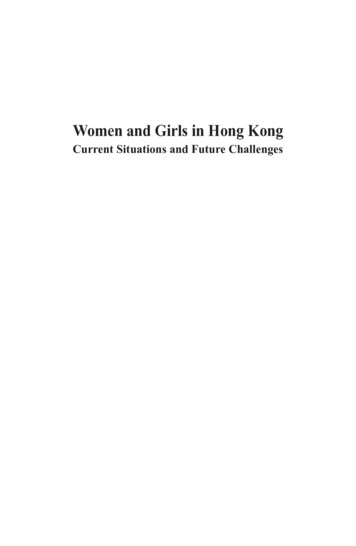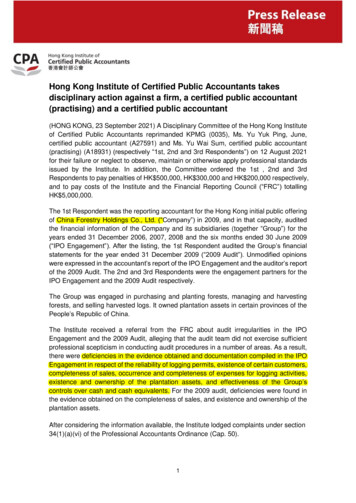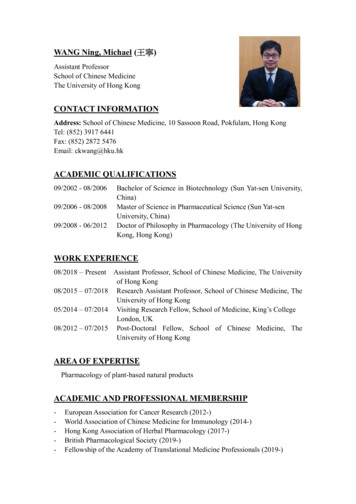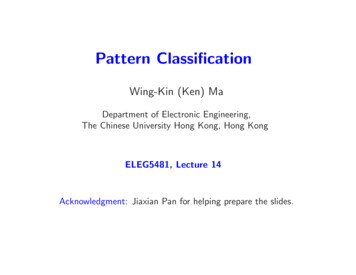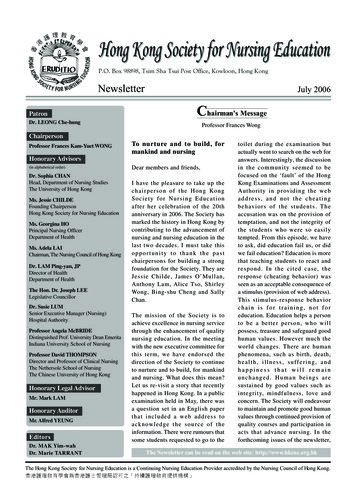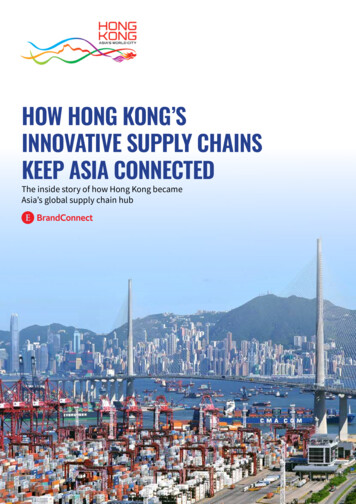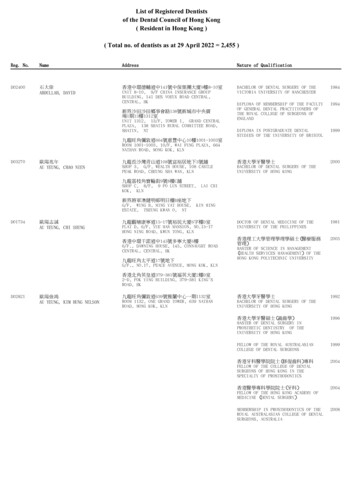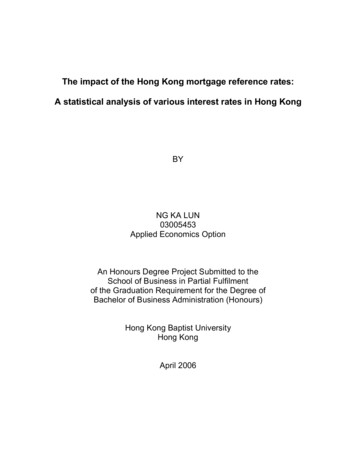
Transcription
The impact of the Hong Kong mortgage reference rates:A statistical analysis of various interest rates in Hong KongBYNG KA LUN03005453Applied Economics OptionAn Honours Degree Project Submitted to theSchool of Business in Partial Fulfilmentof the Graduation Requirement for the Degree ofBachelor of Business Administration (Honours)Hong Kong Baptist UniversityHong KongApril 2006
ContentAbstractAcknowledgment1. IntroductionP.12. Background of Composite rate argumentP.33. Literature ReviewP.54. MethodologyP.85. Empirical ResultsP.136. Limitations of the Model EstimationsP.207. ConclusionP.218. ReferenceP.239. AppendixP.25
AbstractThis paper examines the fundamental differences among the various interestrates in the HK and US mortgage market from 1982 to 2005. The results indicatethat HK Banks generally earn a greater interest margin with a more volatilemortgage rate. The results also suggested that the cost of funding is important forthe mortgage rate determination. It also indicates HKMA has an intention toincrease banking efficiency by the tradeoff of the banking profitability. Moreover,the Composite rate is a better indicator as the mortgage reference rate.
AcknowledgmentsI would like to extent my greatest appreciation to my supervisor, Dr. Sin Chor Yiu,for his continuous contribution, suggestions and supervision to this honour project.This project could not be finished without his helps. In addition, I would like tomake special thanks to every one else who supported me in doing this project,especially for my family and friends.
1. IntroductionIn 1993, Hong Kong Monetary Authority (HKMA) phased the program forliberalizing interest rate in HK. The two main objectives of the program are toincrease the market determination of HK interest rate and to introduce moreintense competition into the banking system in HK. HKMA would like to transformthe existing financial intermediation into a more effective channel, resulting inhigher returns for depositors and a lower cost of funds for borrowers.Besides, the principle of the HKMA is to "promote the general stability andeffective working of the banking system.” Banking industry in HK is under tightrestrictions and supervisory policies. The minimum standards authorizedinstitutions, including banks, are expected to attain. In order to satisfy therequirements of the Banking Ordinances and recommendations on best practices,authorized institutions should achieve them that’s why the entering to this marketis difficult. When we focus on the nature of the banking industry, it needs to havea good monitoring to assure both the banking and monetary stability, so it is betterto control the number of authorized institutions in a limited amount, which helpsthe government to have a better supervision. As the banking stability is critical inHK, HKMA does not encourage an over-competitive market environment. Also,less inter-bank competition would easily arouse the collusion among differentbanks. As collusion is beneficial to banks and harmful to the public, HKMA wouldalso introduce some programs to avoid the collusion problem and restrict or guidethe authorized institution’s behavior.1
As we are going to argue in the paper, to a certain extent, adoption ofComposite rate1 in the mortgage market may be beneficial to HK in severalaspects– less fluctuations in mortgage rate, better information for the mortgageborrowers and even banking stability. However, HK banking authorizedinstitutions do not accept the adoption of Composite rate when they clearly knewthe advantages of Composite rate instead of Best Lending Rate (BLR)2. It may beargued that the banks’ behaviors were highly depended on their self-interests.With these in mind, this paper is thus concerned with how the adoption ofComposite rate influences the mortgage rate fluctuation and examines whetherthe drop of bank profitability with Composite rate adoption will provide thechanges for both micro and macro-economic environments in the mortgagemarket. Section 2 provides background of Composite rate arguments whileSection 3 is the literature reviews, stating related findings. Section 4 provides themethodology, the econometric model used in this paper. Empirical results arepresented in section 5. Finally, Section 6 gives the limitations of the model and theoverall conclusion in Section 7.1The average interest rate of HIBOR3 and Effective deposit rate weighted by amount of interbankborrowings and the deposit composition of the entire banking sector.2The lowest interest rate a bank charges on loans extended to its best customers. The Best Lending Rate isoften used as a base for quoting interest rates on mortgage loans.2
2. Background of Composite rate argumentAfter the introduction of liberalizing interest rate program, the keencompetition led to a narrowing of the net interest margin. HKMA, as a monitor offinancial intermediates, introduced the Composite Rate3 to prevent banks fromignoring the interest rate risk under the intensive competition in mortgage lendingmarket. HKMA claimed that the Composite rate is better than BLR in the views ofboth parties in the mortgage market. HK banks have adopted the BLR as amortgage reference rate for many years.In August 2005, HKMA published a research about the feasibility ofComposite Rate as a reference mortgage rate. The study also highlighted the useof the composite rate, which closely reflected authorized institutions’ cost of fundsfor the setting of mortgage rates, could provide a means for authorized institutionsto better manage the risks of interest rate volatility on their earnings, and helpenhance banking stability. The introduction of composite rate aroused a greatfeedback in banking industry and the feedback shocked HKMA. None of theauthorized institutions decided to adopt the Composite Rate. The reasons ofrejecting Composite Rate are as followings:i)The rate is only weighted rate in one industry which cannot reflectcompletely on the funding cost of individual institution,ii)The rate is a lagged indicator which cannot provide a good measure ofpresent decision,3See HKMA Research Memorandum 09-2005 “Hong Kong Mortgage Rate Setting – An AlternativeReference Rate?”3
iii)The rate is too theoretical and less popular. It is difficult for market to adoptthis rate as mortgage rate in a short period of time.HKMA disagree all arguments stated-above, it responds that:i)Even the funding structures differ from banks, but that do not stop themfrom using the same best lending rate for a long time.ii)HKMA is willing to publish the Composite rate more frequently in order tomatch up the market situation. Moreover, composite rate to some extent isa forecasting indicator.iii)Composite Rate as a reference rate is adopted successfully in UnitedStated. It is feasible for HK to follow.HKMA and the authorized institutions argued that which rate is more suitablefor mortgage reference rate in the customer’s view. And, this paper is going toexamine the adoption of the mortgage reference rate, which is highly dependedon banks’ self-interests.4
3. Literature ReviewAccording to the Journal of Housing Research, many countries adopteddifferent ways to determine the mortgage rate. Moreover, there is no standardizedway to determine the individual mortgage rate.In HK, the most common way is using BLR. However, the BLR sometimes isdifferent among banks after abolishing interest rate agreement of Hong KongAssociation of Banks in 2001. Sin (2006)4 has pointed out that, from the view ofthe nature in banking industry, it is necessary for HKMA to monitor the banks’performance, and profitability. The composite rate provides a higher visibility tothe public on the banks’ profit margin in the mortgage rate. It would entail amonitoring effect of banks when they determine the individual mortgage rate. Themonitoring effect forms a constraint on the interest rate spread between themortgage rate and the cost of funding rate. The market mortgage rate fluctuationwould be less .The profitability of adopting Composite rate as a reference rate ofmortgage would significantly less than BLR. Under the situation which customersdo not truly know the funding cost, implying the asymmetric information,customers would get less bargaining power on the mortgage rate determination.Therefore, banks would have fewer restrictions on mortgage rate determinationand enjoy a greater profit.Also, in order to reduce consumer’s confusion of different BLR, HKMA (2005)4Sin C.Y. (2006), personal communication5
aim at using a standardized cost of funding rate in HK mortgage market. Sincecomposite rate is newly introduced in HK, a study of oversea experience onfunding cost can be a good indicator to evaluate the impact of composite rate inHK. According to the analysis of HKMA (2005), HK has adopted the linkedexchange rate system, the HIBOR5 and BLR in the response of US interest rateadjustment. To some extent, the funding cost in HK is highly link with the changesof US’s funding cost.The study of HKMA (2005) pointed out in time when HIBOR and time depositrate rise faster than BLR (typically during an interest rate hike cycle or when therisk premium of the HK dollar over the US dollar widens), the interest margin ofbanks’ existing mortgage portfolios would be squeezed. This may lead to a sharpdecline in bank’s earnings. And it may influence the banking and financial stability.The market conditions during late January to April 2005 demonstrate such risk.The two criteria for the reference rate assessment are (i) the stability of mortgagerates over time which regarded as the key by both borrowers and authorizedinstitutions, and (ii) conduciveness to risk management of interest rate which isimportant for banking stability. It compares the BLR with other alternativemortgage rates to consider which one enable banks to better track their fundingcost in determining the interest rate for residential mortgage lending. Thecomparative analysis suggested that the composite rate is probably the best wayas it reflects the funding costs closely for most of the banks and it is more stable5The rate of interest offered on HK dollar loans by banks in the interbank market for a specified periodranging from overnight to one year.6
than other reference rates.To summarize the analysis of the literatures, we can use the funding cost inUS as the composite rate for HK in the period of 1982-2005 to compare theimpacts of BLR in HK mortgage market.7
4. MethodologyAs Composite rate is a new topic introduced in HK, there is lack ofeconomists to analysis the effects of adoption Composite rate and BLR. It isdifficult to apply the models from others to make up an empirical framework. Also,the publication on the figures of Composite rate by HKMA is not sufficient (up tillnow, available data has only eight), so there is not enough sample size toevaluate the effects of changes in funding cost to the mortgage rate. The datasets should have some technical estimation in order to assure the findings arereliable. To estimate the Composite rate during the period 1982-20056, thefunding structures and different interest rates in the HK banking industry shouldbe collected. Besides, another important variable in this project is the averagemortgage rate in HK which is not released to the public. Thus, some mortgagerate data should also have some technical estimation to complete the whole dataset7.Furthermore, HK has not adopted the cost of funding index as a reference formortgage rate. Therefore, the data in US mortgage market, as a proxy for themortgage rate affected by the cost of funding index, should be used to evaluatethe effects on the Composite rate. Thus, only basic components, like themortgage rate and the cost of funding index, are included in testing whether HKbanks’ behaviors violate the mortgage rate’s stability in this paper for67The method of calculation is explained in Appendix 9.1The method of calculation is explained in Appendix 9.28
simplification. Goldfeld-Quandt Test is used to examine the size of mortgage ratefluctuation in both HK and US. Also, Ordinary Least Squares (OLS) method isused and several cross-countries regressions with both HK and US data shouldbe run in the period 1982-2005, in order to estimate the fundamental differenceson the effects of both rates in the mortgage markets.There are totally 96 observations in both HK and US. This paper aims atcapturing the impacts on the different mortgage reference rates and how they varyin HK. For simplifying the models, some presumptions have been made.4.1 PresumptionsSome presumptions have been made for simplifying the models. First of all,the mortgage reference rates were BLR in HK and cost of funding rate in UnitedState respectively. Secondly, the cost of funding in HK was very responsive to thechanges of US rate. Thirdly, the publication of Composite rate and the cost offunding index provide more information to customers about the banks profitmargin, which restrict the interest margin of bank into a mild variation.4.2 The differences of HK and US mortgage marketsUnder different mortgage reference rates in HK and US, they would lead todifferent behaviors of banks to determine the mortgage rates. As the cost of9
funding index in US would generally provide more information to the mortgageborrowers and the bargaining power to customers would be increased. While thecustomers in HK obtain less market’s information, HK banks can be more capableto alter the interest rate spread which can improve the profitability of banks. TheGoldfeld-Quandt Test is needed to examine whether different bank’s behaviors inHK and US reflect distinctions on the interest margin fluctuations. And the interestmargin is defined as the mortgage rate minus the cost of funds. More precisely,the model is specified as follows:MR α β1 COF β2 RGDPGWhile MR is the effective mortgage rate, COF is the funding cost of banks, andRGDPG is the real Gross Domestic Product (GDP) growth rate. Positive sign inCOF is expected. And, the real GDP growth rate is a proxy of market mortgagedemand. It is because a better macroeconomics environment would increase themortgage demand.It is also suggested that the HK banks earn an abnormal profit with theimperfect competitive market nature. Therefore, HKMA has a tendency tointroduce new regulation and policy to improve the market efficiency by thestronger market competition. Interest Rate Liberalization is one of the policiesadopted by HKMA. The effect of Interest Rate Liberalization can be a referencefor us to analysis the intention of HKMA. Considering the effect on the interestmargin after the interest rates liberalization, econometric model is constructed asfollows:INTM α β1 PIRL β2 CIRL10
While INTM is the interest margin in the mortgage market, PIRL is the dummyvariable estimating the squeeze of interest margin under partial interest ratesliberalization. And CIRL is also a dummy variable which is used to measure thesqueeze of interest margin under completed interest rates liberalization. PIRL – 1:time series data in HK during 1994 to 2000, when the interest rates liberalizationwas in progress; 0: otherwise. CIRL – 1: time series data in HK during 2001 to2005 when the interest rates liberalization was completed; 0: otherwise. Positivesign in α is expected. The interest margin in most of the time is positive, sincebanks intend to lend fund when it seeks the profit. The PIRL and CIRL dummiesare expected to show negative relationships with the interest margin. The reasonis that the more freedom of interest rate determination, the more intensivecompetition. As such, banks also posted fewer interest margin and profits.4.3 The suitability in the reference rates and the market interest rateUBeside the two key criteria for the assessment, a good mortgage referencerate should closely reflect the changes in the mortgage rate in order to provide abetter insight for the mortgage borrowers. To examine the suitability of thereference rate, a similar model is as following:MR α β REFRMR is the effective mortgage rate and the REFR is the mortgage reference rate(Composite rate or BLR). The β of the two reference rates regression result which11
is near to 1 should be a better indicator, because it is more closely responsive tothe changes of market mortgage rate.To analyze whether there is a long-run interest rate relationship of themortgage rate and the mortgage reference rates, the Cointegration testing isintroduced. As the estimated mortgage rate can be derived by the aboveregression, we can test the goodness-of-fit by the regression error term with timelag.ut - ut-1 β1 ut-1 β2 (ut-1 – ut-2)- β3 (ut-2 – ut-3)BBBBBBBBBBBBBBBBBBBBwhere ui is defined as the difference between the estimate mortgage rate and theBBactual mortgage rate.4.4 Data SourceUThe HK interest rate, deposit structure and mortgage market data are allcollected from the HKMA official website and Hong Kong digest of Statistics. TheHK GDP and price level data are quoted from the Hong Kong Census andStatistics Department. The data on US mortgage market are obtained from theofficial website of Bureau of Economic Analysis, US department of Commerce.And the cost of funding index was cited from the Bank of San Francisco officialwebsite.12
5. Empirical ResultsTable 5.1: Test for Equality between SeriesUµ1 µ2MeanDependent Variable(µ)1 : HK Mortgage Rate8.783.61962 : US Mortgage Rate8.831.70961 : HK Cost of Funds5.433.15962 : US Cost of Funds6.052.75961 : HK Interest Margin3.281.22962 : US Interest Margin2.791.30961 : HK Mortgage Rate8.783.61962 : HK Cost of Funds5.433.15961 : US Mortgage Rate8.841.70962 : US Cost of Funds6.052.7596σ1 σ2S.D. (σ) Count F-statistic P-Value F-statistic 191671.62930.00002.61920.0000Table 5.1 shows the statistics result for the interest rate in HK and US. Notedthat the mortgage interest rate fluctuation in HK is significantly greater than US,on average the standard derivation of mortgage rate is 3.61% in HK and 1.70%in US. The less restriction on HK mortgage determination would definitelyentail a greater lending rate fluctuation of HK Banks. Looking at the cost offunding index, it is not significantly different. It can be accounted for theLinked-exchange rate system between HK and US. The costs of funds areresponsive among each other. Further, the interest margin of HK Banks issignificantly greater than US, and HK Banks can get 0.49% much higher13
interest margin than US banks. This finding supports the argument that HKBanks can earn a greater profit with it negotiated with the less informationcustomers, and the mortgage rate determination by BLR helps HK banks earna greater profit.Beside, the fluctuation of mortgage rate is corresponsive to the variation of thefunding cost in HK but not in US. The US mortgage rate tends to have asmaller changing than the cost of funds. It is because the larger proportion offixed rate mortgage in US and the BLR referenced mortgage dominated theHK market.Table 5.2: Simple Regression Model of Mortgage rate estimated by the Cost ofUFunding and Real GDP Growth Rate of HK and USUMR α β1 COF β2 RGDPG β3 AR(1)14
DependentVariableIndependent Constant (α)VariableCost of Funds (COF)HK Mortgage RateUS Mortgage 3246Real GDP growth 8D.W. Statistics2.09540.51919595ObservationsNotes: ** indicates significance at 1%. T-statistics are given in parentheses.AR(1) variable is used to correct the autocorrelation problem in the model.From Table 5.2, it shows the considering factors when banks setting themortgage rate. The signs of the constant terms are positive, to some extend,the constant term can be expressed into the profit margin when the real GDPgrowth is zero. It shows that the banks would earn a positive interest marginmost of the time no matter the economy situation was. It is reasonable andobvious as all economics theory mentioned before. Moreover, the COF in HKand US are positive, showing the cost of funds leads to a higher mortgage rate.The profit maximizing behavior and the adjustable rate mortgage marketcontribute the reflection of the cost of funding to the mortgage rate. TheRGDPR coefficients are insignificant in both HK and US market, showing thereal GDP growth may not the critical consideration factor of banks to setting15
the mortgage rate. To conclude, the cost of funding dominates the mortgagerate determination.Table 5.3: Simple Regression Model of Interest Margin estimated by theUInterest Rate Liberalization DummyINTM α β1 PIRL β2 CIRL β3 AR(1)DependentHK Interest t 1.6193**-3.1340AR(1)0.63887.6378Adjusted R-square0.6045D.W. Statistics2.1719SEE0.7733Observations95Notes: ** indicates significance at 1%. T-statistics are given in parentheses.The sign of constant term is positive as the previous finding, suggesting thebanks earn interest margin on mortgage market that includes the cost ofoperation. The CIRL dummy coefficient is negatively significant, i.e. after thecompletion of Interest Rate Liberalization, the interest margin of HK banks16
reduce dramatically of 1.62%. Apart from the above result, PIRL also shows anegative coefficient. Even the Interest Rate Liberalization was introduced andnot completed. The stronger market competition caused a squeeze in interestmargin. The reduction of interest margin after the launching Interest RateLiberalization is showing that HKMA having a tendency to increase bankingefficiency by increasing inter-bank competition, which would greatly reducebanks profitability. And, the introduction of Composite rate can also be ameasure of HKMA to increase banking efficiency.Table 5.4: Simple Regression Model of Mortgage Rate estimated by the fitnessUon the Mortgage Reference RateMR α β REFRReference RateComposite rateBLRDependentHK Mortgage RateVariableCoefficientIndependent Constant 0.9521 uare0.86150.8314SEE1.35021.48961982:01 - 2005:121982:01 - 2005:12Sample PeriodNotes: ** indicates significance at 1%. T-statistics are given in parentheses.17
As shown in Table 5.4, all of the coefficients are significant. A better mortgagereference rate should be more closely reflected the mortgage rate movement.Comparing the coefficients of REFR, the Composite rate one is more close to 1and the BLR one is more far way from 1. In the viewpoint of customerconvenience, Composite rate is better than the BLR because the change ofComposite rate has a one-to-one relation with the mortgage rate. It is easier formortgage borrowers to understand and reduce the market confusion onmortgage rate determination.Table 5.5: Cointegration Test of Long-run relationship between Mortgage RateUand Mortgage Reference Rateut - ut-1 β1 ut-1 β2 (ut-1 – ut-2)- β3 (ut-2 – ut-3)BBBBBBReference RateBBBBBBBBBBBBComposite rateBBBLRDependentut – oefficientt-ratio-0.2387-2.4808-0.0729-1.2766ut-1 – ut-2-0.2767-2.4959-0.2633-2.4964ut-2 – sted R-square0.26260.0979SEE1.03270.7415Akaike info criterion2.93402.2714D.W. Statistics1.93642.0677Observations939318
Beside the analysis from Table 5.4, the Cointegration test can further providean informative analysis to the goodness-of-fit on the mortgage reference rates.The time lag of the tests is 3-quarters8. The t-Statistics of Composite rate is-2.4808. It shows a significant result that there are long-run relationship andcointegration between HK mortgage rate and the Composite rate. However,comparing with the Composite rate, the t-Statistics of BLR is -1.2766. Theinsignificant result suggests it cannot conclude an existing of long-runrelationship between HK mortgage rate and BLR. These findings showComposite is a better indicator than BLR for the mortgage rate, which issupporting the HKMA argument and opposing HK banks claiming.8More regression results are showed in the Appendix 9.3, the 3-quarter time-lag model shows the mostreliable finding when we compare the Adjusted R-squared and Akaike info criterion.19
6. Limitations of the Model EstimationsIn my paper, the data of banking deposit in year 1982-2005 are fromofficial website of HKMA and Monthly Digest of Statistics. However, some dataare not available in both materials especially for those deposits in foreigncurrency at the early period, i.e. the 1980s. This cause estimation problemwhen we further estimate the Composite rate using HKMA definition, theremay have some biases in the estimation.Another limitation comes from the data estimated to the HK mortgage rate.The rate is not opened to the public and it is difficult to get the official statisticsdata. And some more calculation needed to make for completing the data set,also there may have some biases in the estimation.20
7. ConclusionMortgage reference rate is a controversial issue in banking industryrecently. The mortgage market brought great impacts over the financial system.Using the OLS model and calculating the Composite rate which since 1982,this paper examines the effects of mortgage reference rate on the mortgagemarket. Several conclusions can be drawn in this paper.First, the HK and US cost of funding is similar. The fluctuation of HKmortgage market is greater than the US, with a higher bargaining power of HKbanks. The results of this paper are not surprising. It found that the higherbargaining power of HK banks also results the greater interest margin. HKbanks get a higher profitability by enlarging mortgage rate fluctuation.Second, apart from the mortgage market structure, in both of HK and US,the economics environment does not act a critical factor to influence themortgage rate. Comparably, there is an important role for cost of funding tosetting the mortgage rate. It can conclude that the cost of funding index can bea good indicator for the mortgage market. There is no different on theimportant role of funding cost in HK and US.Third, the findings suggest HK banks earn a huge profit when themortgage rate was setting. Consequently, my paper further evaluated the21
impact on Interest Rate Liberalization by introducing dummy variables PIRLand CIRL. The squeeze of interest margin provides an insight that HKMAwould like to increase banking efficiency by the tradeoff of the bankingprofitability.Fourth, the Composite rate is a better than BLR as the mortgagereference rate. In term of the changing amount and the long-run relationshipon the two rates (reference rate and mortgage rate), Composite rate makesfewer market confusion, higher stability of mortgage rate and betterconduciveness to the interest risk management of banks.Even replacing the BLR by Composite rate, the change in the pricingmethod would have far-reaching impacts on the mortgage market. And, itcould also a complex process. Composite rate as a mortgage reference ratebeneficial for the customers and improving banking stability, however, bankswould prefer the BLR with its profit maximizing behavior9. The choosing of thereference rate would depend on the bargaining power of the both involvedparties in the future.9A detailed discussion of the Profitability of mortgage reference rates is given as a technical note inAppendix 9.422
8. References1.Jim Wong, Cho-hoi Hui and Laurence Fung (2005). Hong Kong MortgageRate Setting – An Alternative Reference Rate?, Research Memorandum,HKMA2.Market Research Division, HKMA (2005), The Composite Interest Rate ofHong Kong – A New Data Series, Research Memorandum, HKMA3.HKMA Official Website, http://www.hkma.gov.hk4.Hong Kong Census and Statistics Department, Hong Kong digest ofStatistics (1980-2005)5.Hong Kong Census and Statistics Department Official Website,http://www.censtatd.gov.hk6.Bureau of Economic Analysis Official Website, US department ofCommerce, http://www.bea.doc.gov7.Bank of San Francisco Official Website, http://www.fhlbsf.com8.Adrian Coles and Judith Hardt (2000), Mortgage Markets: Why US andEU Markets Are So Different, Housing Studies, Vol.15, No.5, 775-783,20009.Jim Wong, Ka-fai Choi and Tom Fong(2005), Determinants of the CapitalLevel of Banks in Hong Kong, Research Memorandum, HKMA10. Jim Wong, Laurence Fung, Tom Fong and Cho-hoi Hui(2005), InterestRate Risk in the Pricing Of Banks' Mortgage Lending, ResearchMemorandum, HKMA11. Jim Wong, Laurence Fung, Tom Fong and Angela Sze(2004), ResidentialMortgage Default Risk in Hong Kong, Research Memorandum, HKMA23
12. Guorong Jiang, Jim Wong, Nancy Tang and Angela Sze(2004), BankingSector Competition in Hong Kong - Measurement and Evolution OverTime, Research Memorandum, HKMA13. Guorong Jiang, Nancy Tang, Eve Law and Angela Sze(2003),Determinants of Bank Profitability in Hong Kong, Research Memorandum,HKMA14. Wensheng Peng, Kitty Lai, Frank Leung and Chang Shu(2003), TheImpact of Interest Rate Shocks on the Performance of the Banking Sector,Research Memorandum, HKMA15. Jiming Ha and Cynthia Leung(2002), Macroeconomic Implications of USInterest Rates for Hong Kong, Research Memorandum, HKMA16. Priscilla Chiu, Kitty Lai, Simon Wong and Frank Leung (2001), InterestRate Spreads, Research Memorandum, HKMA17. Wensheng Peng, Lillian Cheung, Kelvin Fan and Cynthia Leung (2001),The Property Market and the Macro-Economy, Research Memorandum,HKMA18. Priscilla Chiu and Kitty Lai (2001), Domestic Lending, ResearchMemorandum, HKMA24
9. Appendix9.1 Deriving the Composite rateUComposite rate can be defined as COF as follow
The impact of the Hong Kong mortgage reference rates: A statistical analysis of various interest rates in Hong Kong BY NG KA LUN 03005453 . different among banks after abolishing interest rate agreement of Hong Kong Association of Banks in 2001. Sin (2006)4 has pointed out that, .
